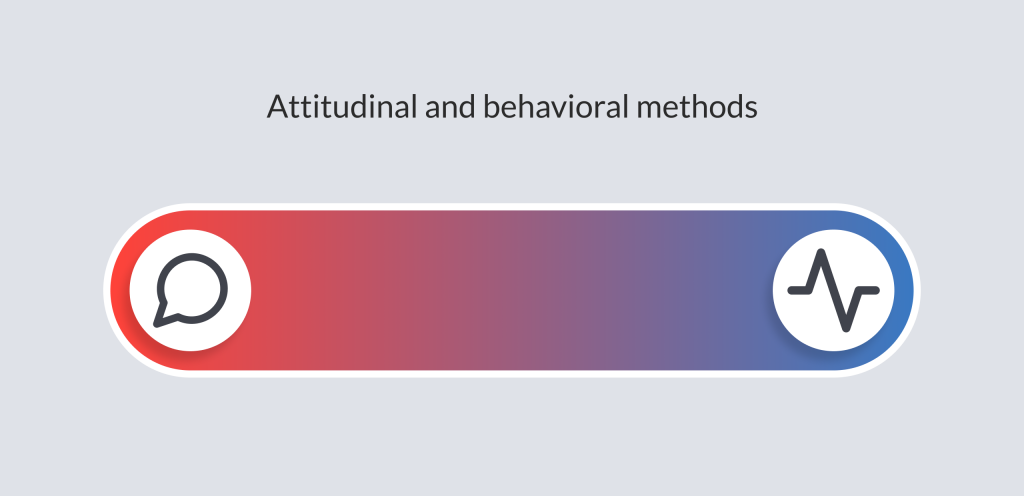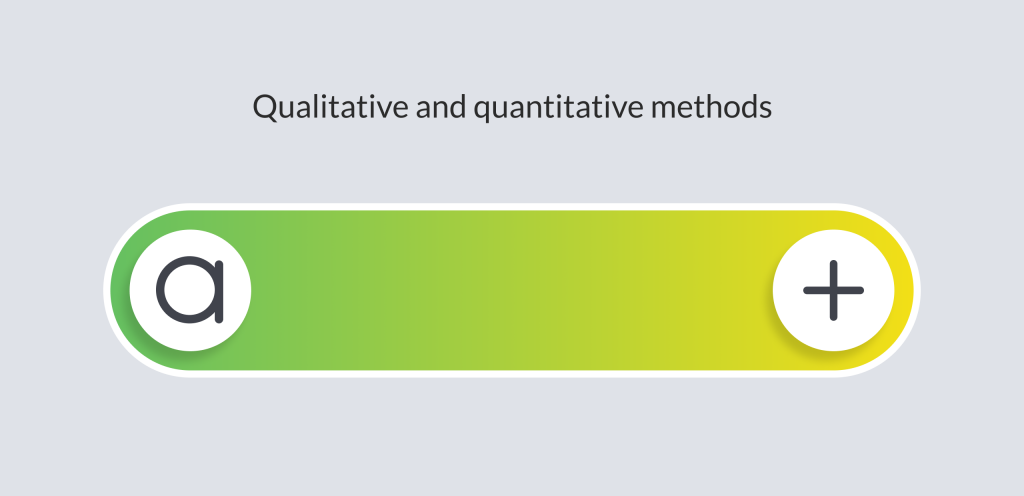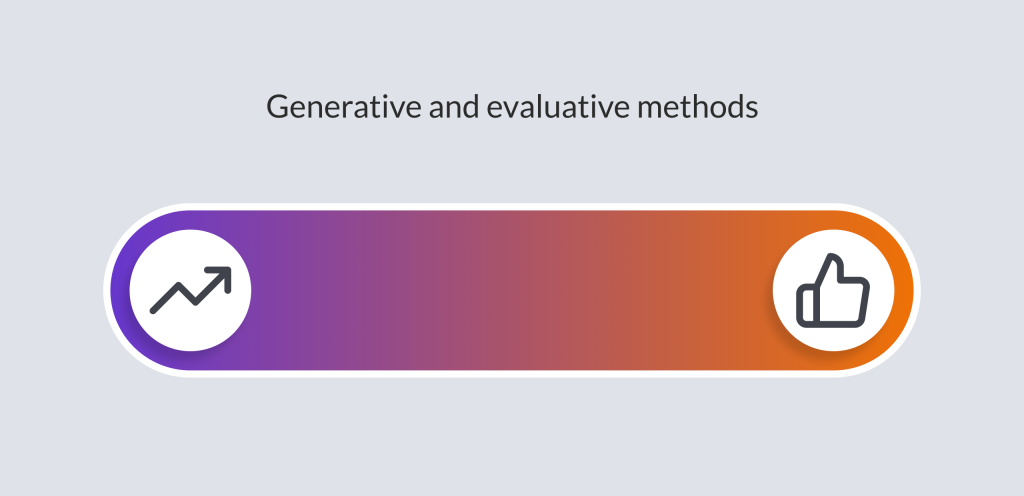
At its core, user research (or UX research) is gaining an understanding of users to inform and guide the design and development of digital products. In a nutshell, different types of user research methods offer various ways to gain this understanding.
By employing UX research methods, designers can craft user-friendly products. These methods offer a structured approach to gathering insights, helping to identify potential issues and opportunities for enhancing the user experience.
The choice of UX research methods depends on several factors, including the research goals, the available resources, and the stage of product development. Defining the correct research method for the study is a crucial element of creating a user research plan (a process you can learn more about in this article).
In general, the project’s research goals will influence the choice of research methods. For instance, if the goal is to understand user preferences for a new product feature, surveys or card sorting might be appropriate choices. If the goal is to identify usability issues with an existing product, usability testing or user interviews could be more suitable.
Regardless of the specific method employed, UX research is vital in ensuring that products are designed with the user in mind. By understanding user needs and behaviors, designers, and developers can create products that are not only easy to use but also enjoyable and engaging, ultimately leading to a more satisfying user experience.
There are different ways of categorizing user research methods. Each category offers a way to answer a specific research question or to reach a particular research goal.
Christian Rohrer, in the article published on the Nielsen Norman Group website, suggests looking at different research methods through the lenses of 3 dimensions. Those three dimensions create three broad categories for user research methods:
We will discuss each category in detail in the next section.

The first dimension reflects what research methods can study. The object of research of those methods is either the behaviors or attitudes of users.
Unfortunately, what study participants say they do and what they actually do are often not the same, and researchers can either focus on one or the other.
Research methods in this category specify either the attitudes of users (what they say) or the behaviors of users (what they do).
Attitudinal methods gather self-reported data about users’ beliefs, attitudes, and opinions.
These methods rely on users’ ability to articulate their thoughts and feelings, and they are particularly valuable for understanding user preferences, motivations, and expectations.
Commonly, researchers use surveys, interviews (either of users or stakeholders), and focus groups to collect attitudinal data.
Behavioral methods, on the other hand, focus on observing and measuring users’ actual behavior.
These methods aim to understand how users interact with products or services, and they can reveal patterns and insights that may not be apparent from self-reported data alone.
This category includes methods like usability testing, eye-tracking, and A/B testing.
The choice between attitudinal and behavioral methods often depends on the research goals and the nature of the research question.
If the goal is to understand user preferences or motivations, attitudinal methods are the way to go. Therefore, researchers often employ attitudinal methods in the early stage of product development, like the discovery phase.
If the goal is to identify usability issues or to measure the effectiveness of a specific design change, behavioral methods may be more appropriate.
These methods find application later in the development lifecycle.
Of course, researchers can use a mix of attitudinal and behavioral methods within a study. A combination of attitudinal and behavioral methods helps gain a more comprehensive understanding of their users.

Qualitative methods allow researchers to learn why users behave in a certain way. They prioritize depth and understanding of the singular users rather than learning about the general behavioral patterns of the users in mass.
Qualitative methods, like interviews, allow researchers to gather verbal and non-verbal data. They can reveal underlying patterns and themes behind the users’ actions that may not be readily apparent through numerical data alone.
To illustrate, analytics on a website will show you that users are not finishing the main tasks. Qualitative research methods allow you to ask them why.
On the other hand, quantitative methods emphasize objectivity and measurement, seeking to quantify user behavior and preferences with numerical data, which can be extremely useful.
Quantitative methods include surveys, card sorting, and eye-tracking that generate measurable data. That data can be statistically analyzed to identify patterns, trends, and correlations. This numerical approach allows researchers to generalize user behavior and preferences across larger populations.
The choice between qualitative and quantitative methods often depends on the research goals and the stage of product development.
Qualitative methods are instrumental in the early stages of product development when the goal is to explore user needs and generate ideas.
Quantitative methods are more suitable in the later stages of product development when the goal is to evaluate the effectiveness of existing designs or to measure the impact of specific design changes.
It is worth mentioning that the distinction between the two is not always obvious. Some methods, like card sorting or A/B testing, are sometimes categorized as methods both qualitative and quantitative. Besides, researchers often use qualitative and quantitative methods in combination.

UX research methods can also be categorized into two types based on their purpose: generative and evaluative. Those two categories reflect the third dimension, which is the stage of product development.
Generative methods generate new ideas and insights. These methods typically find their use in the early stages of product development when the goal is to explore user needs and develop ideas for new products or features. Generative methods include brainstorming and concept testing, and they are invaluable in generating ideas.
Evaluative methods, on the other hand, assess the effectiveness of existing designs or products.
These methods are typically used in the later stages of product development when the goal is to identify usability issues, measure the impact of specific design changes, or validate a product concept.
Researchers use techniques like usability testing and A/B testing to evaluate designs and provide insights into how the design can be improved.
The choice between generative and evaluative methods often depends on the stage of product development and the research goals.
Generative methods are more suitable in the early stages when the focus is on exploration and idea generation. Evaluative methods are more appropriate in the later stages when the focus is on assessment and refinement.
However, it does not mean that evaluative methods can be used exclusively after the product has been launched — quite the opposite. Evaluative methods are often used early in the product development lifecycle to validate whether the solution idea aligns with the users’ needs and whether the design team is on the right track.
Among different types of UX research methods, there are some that researchers use more often than others. Each method finds its use for specific objectives and during a different stage of the product development lifecycle. Here’s an overview of some of the most popular UX research methods:
User interviews involve one-on-one conversations with potential or current users to understand their needs, behaviors, and expectations. Stakeholder interviews are similar but with project stakeholders and are conducted to gather guidelines about the project.
These interviews can be conducted in person or remotely, providing a rich source of qualitative data that can inform design decisions.
Field studies involve observing users’ natural environments to understand how they interact with products or services in real-world settings. This method provides valuable contextual insights into user behavior and can reveal unexpected challenges or opportunities for improvement.
Focus groups involve moderated discussions with potential or current users to gather their opinions, attitudes, and feedback on a particular product, feature, or concept. This method can generate a wide range of perspectives and help identify common themes and areas for further exploration.
In diary studies, researchers ask users to log their experiences with a product or service over an extended time. This method studies how users interact with a product in a more extensive timeframe and can reveal patterns and trends that may not be apparent from shorter-term research methods.
Surveys allow to collect data from a large sample of users through questionnaires or online forms. This method efficiently gathers quantitative data on user preferences, attitudes, and demographics.
Card sorting involves asking users to categorize a set of cards into different groups based on their understanding. This method is used for designing an information architecture of a system. With this method, researchers can see how users perceive the organization of information or the relationships between different items. Card sorting is often used to establish navigation on a website.
Tree testing asks users to navigate a hierarchical information structure to find specific items. This method helps evaluate the effectiveness of website or application navigation structures.
Usability testing involves observing users attempting to complete tasks using a product or service. This method can identify usability issues and areas for improvement in the user interface or interaction design.
Five-second testing involves showing users a product or interface briefly and then asking them to recall what they saw. This method is helpful for quickly assessing the overall impression and memorability of a design.
A/B testing involves comparing two versions of a design or feature to see which one performs better. This method is a powerful way to measure the impact of design changes on user behavior empirically.
Concept testing involves presenting users with early-stage ideas or concepts for a product or service and gathering feedback. This method can validate ideas, identify potential issues, and refine concepts before investing in further development.
Choosing the most suitable approach for your needs can be daunting. You can learn more about it in another article, but to sum up, to make an informed decision, consider the following factors:
Research Goals: Clearly define the objectives you aim to achieve with your research. Are you seeking to understand user needs, identify usability issues, or validate design concepts?
Available Resources: Assess the time, budget, and personnel available for conducting your research. Some methods may require more extensive resources than others.
Stage of Product Development: Consider the current stage of your product development lifecycle. Generative methods are more suitable in the early stages, while evaluative methods are better suited for later stages.
Nature of Research Question: Determine whether you require quantitative or qualitative data. Quantitative methods provide numerical data, while qualitative methods yield insights into user attitudes and motivations.
User Population: Consider the characteristics of your target user group. Some methods may be more effective with specific demographics or levels of familiarity with the product or service.
Choosing between types of UX research methods means carefully considering these factors. Remember that the choice of method is not rigid; combining different methods can often provide a more comprehensive understanding of the user experience.
User experience (UX) research is crucial in ensuring products are designed with the user in mind.
By employing various UX research methods, designers and developers can gain valuable insights into user needs, behaviors, and expectations, ultimately leading to products that are not only functional but also enjoyable and engaging.
The diverse array of UX research methods encompasses quantitative and qualitative approaches, generative and evaluative techniques, as well as a range of specific methods such as user interviews, field studies, focus groups, diary studies, surveys, card sorting, tree testing, usability testing, five-second testing, A/B testing, and concept testing.
The choice between different types of UX research method depends on various factors, including research goals, available resources, stage of product development, nature of research question, and user population. By carefully considering these factors, designers and developers can select the most appropriate method to gain a comprehensive understanding of the user experience and create products that meet user needs and expectations.